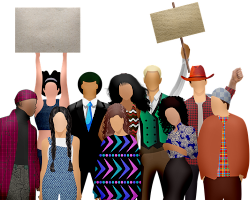 The First Amendment to the U.S. Constitution guarantees “the right of the people peaceably to assemble and to petition the Government for a redress of grievances.” The Boston Tea Party, Civil Rights protests, Women’s Right to Vote marches, Black Lives Matter protests, Iraq War protests, Vietnam War protests, Occupy protests, LGBTQ rights marches, Dakota Access Pipeline protests, March for Our Lives, March for Science—these are just some of the many examples of people exercising their first amendment rights through protest. For generations, people have been using protests as a way to make their voices heard, call attention to an issue, influence government policy, and change the world. Millions of people have protested and marched in an effort to fight against injustices and enact social change. In the thick of these protests, it is sometimes hard to see what they accomplish but in the long term, protests have often succeeded in bringing about important change and even altering the course of history. In celebration of our right to assembly, check out the diverse selection of protest-related e-books listed on our WU Reads Reading Guide.
The First Amendment to the U.S. Constitution guarantees “the right of the people peaceably to assemble and to petition the Government for a redress of grievances.” The Boston Tea Party, Civil Rights protests, Women’s Right to Vote marches, Black Lives Matter protests, Iraq War protests, Vietnam War protests, Occupy protests, LGBTQ rights marches, Dakota Access Pipeline protests, March for Our Lives, March for Science—these are just some of the many examples of people exercising their first amendment rights through protest. For generations, people have been using protests as a way to make their voices heard, call attention to an issue, influence government policy, and change the world. Millions of people have protested and marched in an effort to fight against injustices and enact social change. In the thick of these protests, it is sometimes hard to see what they accomplish but in the long term, protests have often succeeded in bringing about important change and even altering the course of history. In celebration of our right to assembly, check out the diverse selection of protest-related e-books listed on our WU Reads Reading Guide.
Let us remember, we are all part of one American family. We are united in common values, and that includes belief in equality under the law, basic respect for public order, and the right of peaceful protest. – Barack Obama
